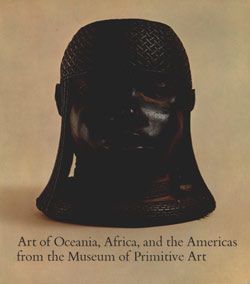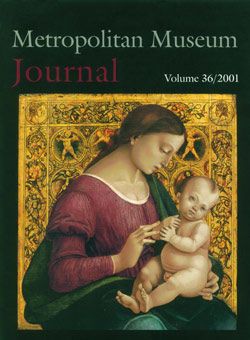Bwanga bwa cibola (maternity power figure)
Luluwa artist and mpaka manga (ritual specialist)
This intricately carved representation of a mother holding her child to her side is a Luluwa maternity figure. The figure belongs to bwanga bwa cibola, a social association or "cult" that addresses issues of human fertility and functions as part of the complex magico-religious world of the Luluwa peoples. Within this world, ritual healers known as mupaki or mpaka manga are endowed with mystical powers and play a vital role in the community by controlling and directing supernatural forces. Procreation is an essential goal in Luluwa society and consequently manga are often called upon to boost fertility and protect pregnant women, newborns, and small children. Manga utilize power objects, or bwanga, as containers and focal points of supernatural forces. The shape of the bwanga and the materials of which they are made vary greatly; many are natural, unworked objects such as gourds or animal horns, while others take the form of wooden anthropomorphic representations such as this example from the Museum's collection.
The rendering of the mother figure conforms to accepted notions of beauty in Luluwa culture. Female beauty is an essential element in the ability to attract the ancestral spirits; it serves as an invitation to the ancestral spirits to inhabit the sculpture and thus exercise a positive influence on pregnancy, birth, and the health of the newborn. The figure's long neck and muscular limbs express positive aesthetic values. The concentric lines on the neck are either scarification patterns (nsalu) or necklaces, or possibly both. Luluwa women of status would often wear necklaces of blue and white beads to signify their rank. The large head and high forehead are indicators of beauty that also symbolize intelligence and willpower. The strong calves of the figure suggest a capacity for hard work, a quality much sought after by men when choosing a partner. The coiffure, jewelry, and extensive scarification patterns make apparent that this figure represents not only a beautiful woman, but one of high rank as well. The Luluwa associate body decoration with the unified notion of physical and moral beauty, in effect combining Western concepts of "beauty" and "good." At the same time, the nsalu are also a reference to human or cultural beauty, that is, beauty created by humans themselves. The coiffure depicted on this figure dates to the nineteenth century and consists of a vegetable-fiber wig, rows of cowrie shells woven into the hair at the back of the head, and a pointed shape at the top. Another significant characteristic of this figure is the protruding navel, which depicts the once highly coveted umbilical hernia. The navel symbolizes the close relationship between ancestors and progeny and also alludes to the succession of generations. The detailed depiction of a shell pendant between the shoulder blades of the figure is a direct reference to the cibola cult, as are the sculpted renderings of the loincloth and belt.
The anthropomorphic conventions of this figure place it within a particular context of the artistic and sociopolitical history of the Luluwa peoples. Refined, intricately carved figures such as this are rare within the bwanga repertoire; most other examples are simpler, roughly hewn, and classified as "schematic." Scholars believe that the relatively "naturalistic" carving style was developed after the "schematic" style sometime during the mid- to late nineteenth century. It also appears that refined figures such as this belonged principally to a restricted class of women in positions of authority, which may also explain why such bwanga are so rare. The Luluwa were originally composed of a number of egalitarian groups. By the end of the nineteenth century, however, an unofficial but nonetheless very real class distinction had emerged in various regions of Luluwa territory. Naturalistic cibola figures, as much status symbols as ritual objects, are a likely result of this development. The production of naturalistic bwanga ended during the early twentieth century, when colonial powers subjugated the territory and curbed the power of the Luluwa elite. The most important factor contributing to the rarity of such pieces in Western collections remains the fact that most users did not preserve their bwanga. Manga and practitioners of cibola usually destroyed all their paraphernalia once their membership in the cult had ceased, and many other bwanga were placed at the grave or buried along with their owners.
This image cannot be enlarged, viewed at full screen, or downloaded.



